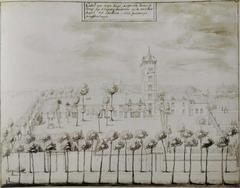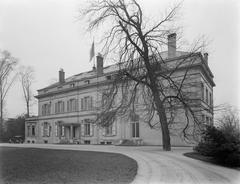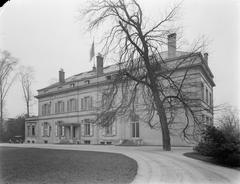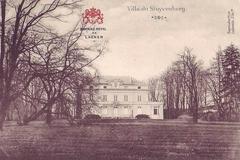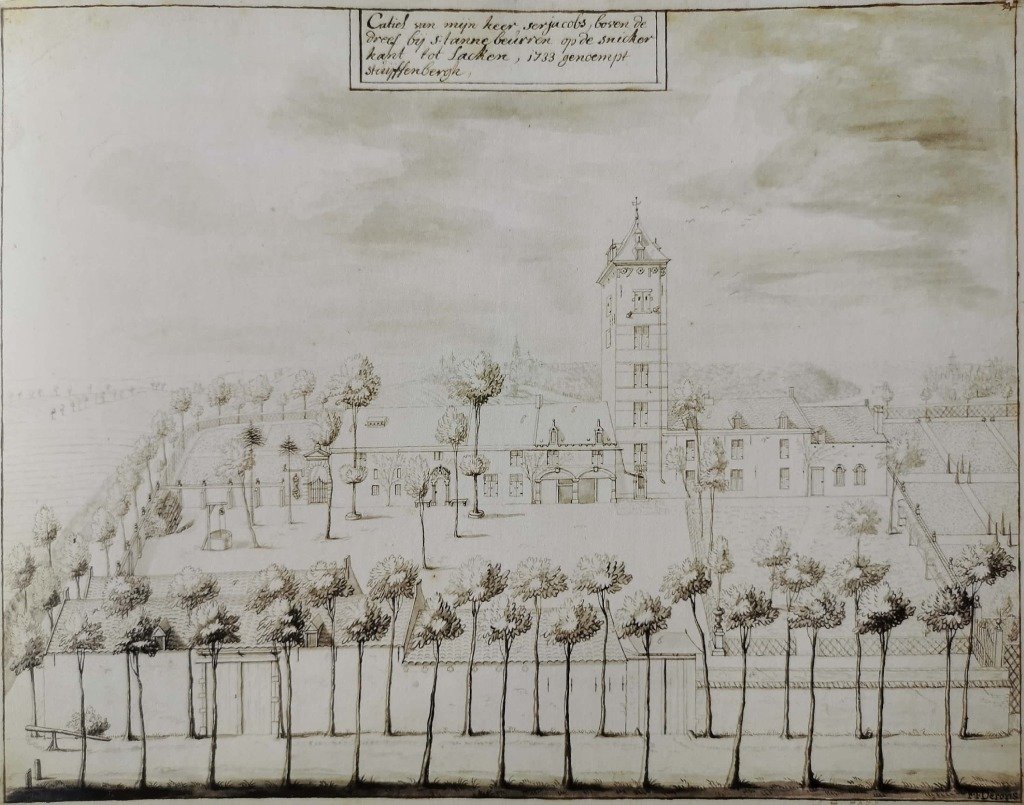
Château du Stuyvenberg: Visiting Hours, Tickets, and Attractions in Brussels
Date: 15/06/2025
Introduction
Nestled in the lush Royal Domain of Laeken, Château du Stuyvenberg is an iconic symbol of Belgium’s royal heritage and a quintessential example of neoclassical architecture in Brussels. Although the château itself remains a private residence and is not open for public tours, its storied past, elegant façade, and meticulously designed French formal gardens offer visitors a unique window into the world of the Belgian monarchy. This comprehensive guide explores the château’s history, architecture, landscape features, practical visitor information including accessibility, and recommendations for maximizing your cultural experience in Brussels. For those seeking to immerse themselves in the royal traditions and historical landmarks of the city, official resources and specialized tours are available. (Belgian Royal Residences - Unofficial Royalty, Visit Brussels Official Tourism, Royal Greenhouses of Laeken, BELvue Museum)
Table of Contents
- Overview: Château du Stuyvenberg in Brussels Royal History
- Historical Background
- Architectural and Landscape Highlights
- Visiting Hours and Ticket Information
- Accessibility & Travel Tips
- Special Events and Nearby Attractions
- Suggested Itinerary
- Local Gastronomy & Cultural Experiences
- Frequently Asked Questions (FAQ)
- Visual Highlights
- Internal & External Resources
- Conclusion
Overview: Château du Stuyvenberg in Brussels Royal History
Château du Stuyvenberg, located in the Royal Domain of Laeken, is a distinguished residence intertwined with the Belgian royal family. Originally built in 1725, it became part of the royal estate in the 19th century and has since served as a home for notable royals, including King Leopold I, Queen Elisabeth, Queen Fabiola, and Kings Baudouin and Albert II. Although private, the château and its gardens can be admired from the surrounding parklands, while the broader Royal Domain and nearby attractions like the Atomium and Royal Greenhouses of Laeken offer rich experiences for visitors.
Historical Background
Château du Stuyvenberg was constructed in 1725 for a noble family and has undergone significant transformations, reflecting the evolution of Belgian aristocratic and monarchical traditions. The Belgian State acquired the property in 1840, and King Leopold II later donated it to the Royal Trust. The château became closely associated with the royal family, serving as a residence for King Leopold I, Queen Astrid, and the birthplace of future Kings Baudouin and Albert II. It has also accommodated foreign dignitaries and, more recently, Queen Fabiola until her passing in 2014. Since 2017, it has been rented privately, further cementing its legacy as a significant royal residence. (Wikiwand)
Architectural and Landscape Highlights
Architectural Features
- Style & Construction: The château exemplifies 18th-century Belgian neoclassical architecture, with a symmetrical façade, hipped roof, dormer windows, and tall sash windows. Its understated elegance is complemented by subtle decorative details. (Wikipedia, Castlepedia)
- Evolution: Notably, a circular tower designed by Charles Girault was added in 1904 (since demolished), and auxiliary buildings like the “Ferme Rose” enrich the estate’s architectural diversity. (Monument Heritage Brussels)
- Interior: While closed to the public, the interior reportedly features refined salons, period furnishings, and royal art collections.
Gardens and Natural Setting
- French Formal Gardens: Designed by landscape architect Lainé, the gardens are laid out in the “jardins à la française” style, with symmetrical parterres, clipped hedges, ornamental ponds, and mature trees such as chestnut and magnolia. (Monument Heritage Brussels)
- Integration: The château is harmoniously integrated into the Royal Domain of Laeken, blending formal gardens with rolling lawns and heritage trees, contributing to the serene atmosphere of the estate. (Lonely Planet)
Visiting Hours and Ticket Information
- Château du Stuyvenberg: The château is a private residence and not open to the public. There are no regular visiting hours or tickets for interior access.
- Royal Greenhouses of Laeken: The famous greenhouses, located within the Royal Domain, are open for a few weeks in spring (typically April–May). Tickets are required and can be purchased online or at the entrance (Royal Greenhouses Visitor Info).
- Exterior Views: Visitors can admire the château’s exterior from public paths in Parc de Laeken and Avenue des Trembles at any time.
Accessibility & Travel Tips
- Public Transport: Laeken is accessible via Brussels Metro (Line 6, ‘Stuyvenbergh’ or ‘Laeken’ stations), tram lines 3 and 7, and several bus routes. (STIB Brussels Transport)
- By Car: Parking is limited; public transport is recommended due to security around royal properties.
- Accessibility: The surrounding parklands offer accessible paths, though some areas may be uneven.
- Best Viewing: Early morning or late afternoon light provides optimal conditions for photography of the château and gardens.
Special Events and Nearby Attractions
- Royal Greenhouses Opening: The highlight of the spring, featuring remarkable architecture and rare plants.
- Guided Tours: While the château itself is not open, guided walking tours of the Royal Domain and Laeken neighborhood are available through local tourist agencies.
- Nearby Sights:
- Royal Palace of Laeken: Official residence of the Belgian monarch.
- Atomium: Iconic modernist structure with panoramic city views.
- Mini-Europe: Miniature park of European landmarks.
- Parc de Laeken: Expansive public park with lakes and gardens.
- Les Galeries Royales Saint-Hubert: Historic covered shopping arcade.
- Grand Place: UNESCO heritage square.
- Royal Museums of Fine Arts: Premier art museums.
Suggested Itinerary
- Morning: Walk the Royal Domain of Laeken, view Château du Stuyvenberg and Royal Palace from public areas.
- Midday: Visit the Royal Greenhouses (in spring) or head to the Atomium and Mini-Europe.
- Afternoon: Explore central Brussels—Grand Place, Les Galeries Royales Saint-Hubert, and sample local cuisine.
- Evening: Enjoy art at the Royal Museums or relax in Parc Josaphat.
Local Gastronomy & Cultural Experiences
- Cuisine: Don’t miss Belgian waffles, stoemp, waterzooi, shrimp croquettes, and world-famous chocolates, especially near Les Galeries Royales Saint-Hubert.
- Culture: Explore Brussels’ Art Nouveau architecture in the Ixelles and Marolles districts through guided walking tours.
Frequently Asked Questions (FAQ)
Q: Can I tour Château du Stuyvenberg’s interior?
A: No, the château is a private royal residence and is not open to the public.
Q: Are there public events at Château du Stuyvenberg?
A: The château itself does not host public events, but the Royal Greenhouses open for a few weeks in spring.
Q: How do I get there using public transport?
A: Take Metro Line 6 to ‘Stuyvenbergh’ or ‘Laeken’ or use tram lines 3 or 7; several bus routes serve the area.
Q: Is the Royal Domain of Laeken accessible for people with mobility issues?
A: Most public paths are accessible, though some garden areas may be uneven.
Visual Highlights
Alt tags include “Château du Stuyvenberg royal residence exterior in Brussels” and “Château du Stuyvenberg visiting hours” for SEO.
Internal & External Resources
- Belgian Royal Residences - Unofficial Royalty
- Visit Brussels Official Tourism
- Royal Greenhouses of Laeken
- BELvue Museum
- Wikipedia - Château du Stuyvenberg
- Spotting History - Château du Stuyvenberg
- Castlepedia - Château du Stuyvenberg
- Monument Heritage Brussels
- Lonely Planet - Château Stuyvenberg
- Wikiwand - Château du Stuyvenberg
- Belgian Monarchy Official Site
- STIB Brussels Transport
- Visit Brussels Attractions
For further exploration, see our guides on Royal Palace of Brussels and Royal Greenhouses of Laeken.
Conclusion
While Château du Stuyvenberg’s interiors remain private, the estate’s elegant architecture, serene gardens, and royal connections make it a valuable highlight for those interested in Brussels’ heritage. Pair your visit to the Royal Domain with a stroll through the gardens, a springtime tour of the Royal Greenhouses, and a circuit of Brussels’ other historic sites for a memorable and culturally rich experience. To deepen your understanding, take advantage of guided tours, reputable digital resources, and the Audiala app for curated itineraries and up-to-date visitor information.
